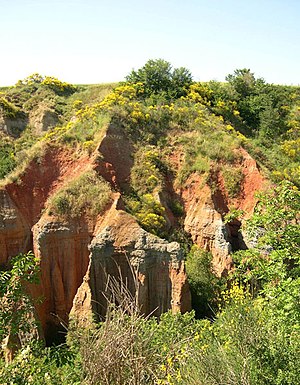
Back تربة أحفورية Arabic Paleosòl Catalan Palaeosol Welsh Paläoboden German Paleosuelo Spanish خاک فسیلی Persian פלאוסול HE Paleosuolo Italian Paleosol Dutch Paleosol NN


In geoscience, paleosol (palaeosol in Great Britain and Australia) is an ancient soil that formed in the past. The definition of the term in geology and paleontology is slightly different from its use in soil science.
In geology and paleontology, a paleosol is a former soil preserved by burial underneath either sediments (alluvium or loess) or volcanic deposits (lava flows or volcanic ash), which in the case of older deposits have lithified into rock. In Quaternary geology, sedimentology, paleoclimatology, and geology in general, it is the typical and accepted practice to use the term "paleosol" to designate such "fossil soils" found buried within sedimentary and volcanic deposits exposed in all continents.[1][2]
In soil science the definition differs slightly: paleosols are soils formed long ago that have no relationship in their chemical and physical characteristics to the present-day climate or vegetation. Such soils are found within extremely old continental cratons, or in small scattered locations in outliers of other ancient rock domains.
- ^ Retallack, G.J. (2001). Soils of the Past (2nd ed.). New York, NY: Blackwell Science. ISBN 0-632-05376-3.
- ^ Kraus, M.J. (1999). "Paleosols in clastic sedimentary rocks: Their geologic applications". Earth-Science Reviews. 47 (1): 41–70. Bibcode:1999ESRv...47...41K. doi:10.1016/S0012-8252(99)00026-4.
© MMXXIII Rich X Search. We shall prevail. All rights reserved. Rich X Search